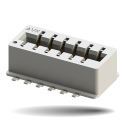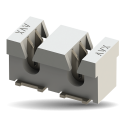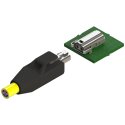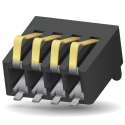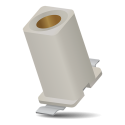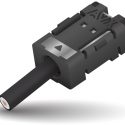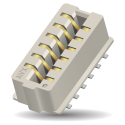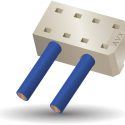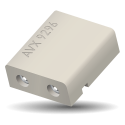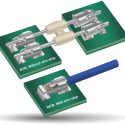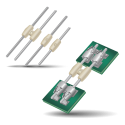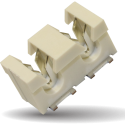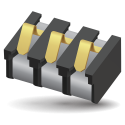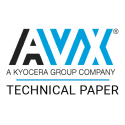Card Edge Connectors for Lighting Applications Written By: Raul Saucedo Abstract: For more than 50 years, the PCB edge connected circuit card has been a mainstay in both desktop and server computers. The traditional arrangement of backplanes and motherboards with numerous card edge slots allowed for configurability and expansion in a rapidly advancing industry. The natural result was an evolution of edge card connector technology focused on higher contact densities and improved electrical performance to try and maximize speed and throughput. More recently, card edge connectors have taken on a new role in the world of solid state lighting (SSL) as the LED has become the dominant source of efficient illumination. LED lighting can be split into two broad categories:
Connectors
Connectors for Medical Device PCBs Written By: Ajay Saini Abstract: The term “medical device” covers a broad spectrum of electrical equipment, ranging from small implantable stimulators to room sized MRI machines. This equipment is typically broken down into three classes based on the safety implications of possible failure modes. Class I devices present minimal potential for harm to the user and are often simpler in design. 47% of medical devices fall into this class, and 95% of these are exempt from any special regulatory oversight. Once appreciable safety concerns come into play, the device is elevated to Class II status. Class III devices require the utmost scrutiny and are subject to intense regulatory oversight, putting them into a category of
Passive Component Advancements for SPE Connectors and Circuit Protection Devices Written By: Daniel West | Julian Wilson Abstract: As Single Pair Ethernet (SPE) begins to roll out there will be a need for easy to implement, yet reliable wire-to-board interconnects. Purchasing finished cable and connector assemblies is not always economical or viable. However, it is also undesirable to work with time consuming and difficult to process connectors. Insulation Displacement Connectors (IDC) and Press-Fit technology (images below) require no crimping or soldering processes, and is easily converted to a streamlined process, while maintaining the versatility of cable lengths and positioning. In addition to reliable retention forces and gas tight seals afforded by the cold weld mechanism of IDC, signal integrity is
High-Performance Battery Contacts for Mobile Electronics Written By: Ajay Saini Abstract: KYOCERA AVX offers the broadest standard battery connector line available on the market today. These robust connectors, available in horizontal and vertical options, are suited for battery pack integration and general board-to-board connection.
Vertical Wire-To-Board Solutions for Solid State Lighting and Industrial Applications Written By: Raul Saucedo | Jon Schifferdecker Abstract: Solid-state lighting (SSL) and industrial applications often must overcome more stringent constraints on environmental tolerance and physical form factor. Primarily, thermal issues of heat dissipation and high-temperature reliability. One popular solution to address these issues is the use of metal core circuit boards.
IDC Shark Fin Connectors for RF Communications Written By: Alex Guan Abstract: Shark fin antenna units offer an attractive, aerodynamic, and functional way to provide the necessary antennas to the vehicle systems. RF antenna systems use coaxial cables, and the most common method to connect those cables to the printed circuit board assembly in the shark fin antenna is manual soldering.
KYOCERA AVX Card Edge Connectors For Automotive Applications Written By: Ashok Dhulgande | John McCarry Abstract: This whitepaper discusses key design considerations for electrical spring contacts and board connections and provides an overview of KYOCERA AVX’s card edge connectors for automotive applications.
Criteria for Selecting Connectors for LED Lighting/Industrial Applications Written By: Jeffery Wang | John Lee Abstract: Connectors used in industrial and solid-state lighting applications pose uniquely challenging design constraints on power density and form-factor while simultaneously demanding the highest reliability under harsh environmental conditions. As a designer in these spaces, one cannot simply prioritize piece cost in the connector selection process. The true value of a connector is much more nuanced and must include the amortized costs of manufacturability, reliability, and safety. Eliminating hand soldering, ease of use, and good yield are not free. Avoiding field failures and product recalls are not free. Regulatory compliance is not free. To best address these hidden costs, designers should choose connectors from suppliers
LED Lighting Interconnects Solutions Written By: Alex Guan Abstract: Solid-state lighting (SSL) solutions based on the light-emitting diode (LED) and its organic relative (OLED) have become the standard for luminaires across a wide variety of application sectors. SSL performance with respect to luminous output, power efficiency, lifetime, and reliability is unmatched. Many of the challenges endured by early adopters, such as cooling, manufacturability, and form factor limitations, have largely been solved. By the year 2035, it is projected that 85% of all lighting installations will be solid-state (“2019 Lighting R&D Opportunities”).
Five Advantages of AVX Poke-Home Connectors Written By: Raul Saucedo Abstract: The poke-home connector was originally introduced as a highly reliable solution for connecting a small number of discrete wires to a printed circuit board assembly. The wire is first stripped, and it is then inserted into the connector. Integral wire guides and an end stop assure proper positioning of the wire during insertion. Dual beam high force contacts (typically beryllium copper) provide extremely low electrical resistance and maximize wire retention. An example of a horizontal poke-home connector is shown in…
AVX Jumper Pins: Solutions for Solid-State Lighting Board-to-Board Applications Written By: Raul Saucedo Abstract: It is now a foregone conclusion that solid-state lighting (SSL), specifically based on the light-emitting diode (LED) and it’s organic relative (OLED), will become the technology standard for luminaires across a wide variety of application sectors. Its performance with respect to luminous output, power efficiency, lifetime, and reliability is unmatched. Many of the challenges endured by early adopters, such as cooling, manufacturability, and form factor limitations, have largely been solved. By the year 2035, it is projected that 85% of all lighting installations will be solid-state (“2019 Lighting R&D Opportunities”).
The History of Insulation Displacement Technology Written By: Hank Merkle Abstract: The need to physically connect pieces of metal together has been around for thousands of years. In the modern era of electronics, the physical connection requirement is compounded by the need for a low resistance electrical path. In both cases, the process of soldering has proven to be an excellent and time tested solution, with evidence dating back to 4,000 BC. Soldering two metal components together means that the joint is heated and a filler metal with a lower melting point than the constituent pieces is deposited to complete the connection.
Connector Solutions for Automotive & Transportation Applications Written By: Matthew Lawrence Abstract: Wiring interconnect in the transportation sector continues to evolve at an extremely fast pace. Automotive technologies, largely driven by electric vehicles and self-driving systems, are placing particularly stringent demands on wiring connectors. On one hand, high-speed busses like automotive ethernet are reducing total wire weight and complexity. On the other hand, reliability requirements are becoming more demanding with 200,000-mile lifetime expectations and routine reliance on highly advanced sensor technologies such as radar and video.
The 3 Rs of IDCs: Reliability, Repeatability, Reparability Written By: Tom Anderson Abstract: Even after more than 50 years in the marketplace, insulation displacement connectors (IDCs) continue to prove themselves in new and demanding applications, such as automotive safety systems, solid-state lighting (SSL), and industrial sensors and controls. IDCs have provided a cost-effective and reliable alternative to crimp-to-wire and hard-soldering wires to a PCB.
Portable Electronics Require Smaller, More Modular SMT Battery Connectors Written By: Tom Anderson Abstract: Next-generation battery connectors face many new market demands, although the common ingredients remain the same: high life cycle, stability, simple design, and SMT compatibility.
Aluminum Electrolytic Capacitor Holder For Ruggedized Automotive Applications Written By: Tom Anderson Abstract: Harsh environments such as automotive and industrial applications can be very demanding on larger electronic components, which are exposed to severe shock and vibration requirements. In order to protect these components, extra attention and most often times cost needs to be devoted to the processing and mechanical attachment within the device to the Printed Circuit Board (PCB).
